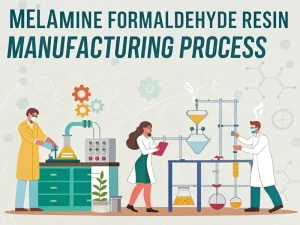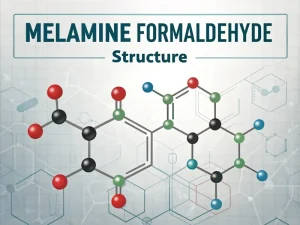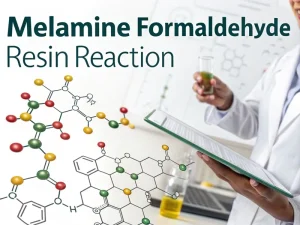
Melamine Formaldehyde Resin Manufacturing Process
Tech Blog melamine formaldehyde resin manufacturing process Melamine formaldehyde (MF) resin is a core material in modern manufacturing, known for its heat resistance, durability, and

Melamine formaldehyde (MF) resin is a core material in modern manufacturing, known for its heat resistance, durability, and flame-retardant properties. It is a key component of high-pressure laminates, kitchen countertops, tableware, and industrial coatings, providing unique hardness, heat resistance, and gloss.
After solidification, it forms a rigid crosslinked structure that cannot be melted or reshaped, making its manufacturing process irreversible and highly dependent on precise reaction conditions.
The entire process begins with two primary raw materials:
Melamine (C₃H₆N₆): white crystalline powder. Melamine molecules are stable cyclic structures rich in nitrogen, providing a skeleton and multiple reaction sites for constructing the final polymer network.
Formaldehyde (CH₂O): usually used in aqueous solution, called formalin (usually 37-50% formaldehyde aqueous solution). Formaldehyde acts as a “linker” or “crosslinking agent” to build bridges between melamine molecules.
The manufacturing process of MF resin consists of five core stages, each aimed at controlling reaction activity, crosslinking degree, and final performance.
Hydroxymethylation is the initial reaction stage, during which melamine reacts with formaldehyde to form a water-soluble intermediate – hydroxymethylated melamine. This step lays the foundation for subsequent crosslinking.
Ingredients: Add formaldehyde (formalin) aqueous solution into the reactor.
PH adjustment: By adding alkaline substances such as sodium hydroxide, the pH of the formaldehyde solution is precisely adjusted to an alkaline range (usually 7.5-8.5). This is crucial because the initial reaction (the methylation reaction) is most effective under alkaline conditions.
Add melamine: Then, slowly add melamine powder to the stirred formalin.
Addition reaction (methylation): Heat the mixture (usually to about 70-90 ° C). Heating triggers an addition reaction, in which formaldehyde molecules bind to the amino group (-NH₂) on the melamine ring. This forms various’ hydroxymethyl melamine ‘(such as dihydroxymethyl melamine, trihydroxymethyl melamine). The reaction is exothermic; therefore, a cooling system for the reactor is required to maintain the target temperature. At this point, the mixture is a clear, water-soluble syrup-like liquid.
During this stage, hydroxymethylated melamine undergoes partial condensation, forming low-molecular-weight prepolymer linear or mildly branched molecular chains, which subsequently crosslink into a three-dimensional network.
This is a crucial stage for the formation of resin networks and the gradual development of material properties.
PH change: The mixture’s pH decreases to weakly acidic (usually 5.5-6.5). This acidic environment can catalyze condensation reactions.
Condensation reaction: Hydroxymethylmelamine molecules begin to react with each other. They form strong methylene bridges (-CH₂-) and ether bonds (-CH₂-O-CH₂-) between melamine rings. Every time a bridge bond forms, a small molecule—usually water (H₂O)—is released, which is why it is called a “condensation” reaction.
Viscosity increase: As more melamine rings are interconnected, the polymer chains grow longer and begin to crosslink, forming a complex three-dimensional network. This leads to a steady increase in viscosity (consistency) of the resin slurry. This stage requires careful monitoring, as the final viscosity required depends on the resin’s intended use.
At this time, the resin contains a large amount of water, which comes from the initial formaldehyde solution and condensation reaction. In many applications, it is necessary to remove this moisture.
Vacuum application: Apply vacuum to the reactor. This will lower the boiling point of water, allowing it to evaporate at lower temperatures, thereby preventing premature curing of the resin.
Concentrate: Remove water vapor and concentrate the resin to the desired solid content (e.g., 50-80%).
Before the process is completed, the resin can be modified for specific purposes.
Additives: Depending on the final product, additives such as plasticizers (to increase flexibility), pigments (to color), or release agents can be added to the resin.
Cooling: The resin needs to be rapidly cooled to terminate the condensation reaction. If the temperature is kept high, the resin will continue to crosslink and may solidify in the reactor—this is a costly problem known as “gel”.
The final form of resin depends on its intended use.
Liquid resin: The cooled and concentrated syrup can be stored in tanks and sold as liquid adhesive or laminated resin.
Spray drying pulverizing: For tableware and other applications, liquid resin is pumped into the spray dryer. In the hot air flow, the resin is atomized into small droplets, and the remaining water evaporates instantly. Finally, a fine and dry melamine molding powder was obtained. This powder is usually mixed with fillers such as cellulose before being sold.
High M: F (e.g., 1:3): Generate resins with lower crosslinking density and greater flexibility, suitable for adhesives.
Low M: F (such as 1:6): increases crosslinking, improves heat resistance, and is suitable for flame-retardant materials.
The alkaline pH (8-10) during the hydroxymethylation stage prevents premature crosslinking.
The weakly acidic pH (5-7) during the condensation stage ensures the controllable formation of prepolymers.
The acidic pH (4-6) during the curing stage promotes complete crosslinking.
Excessive temperature during the hydroxymethylation stage can lead to gelation.
Insufficient curing time will result in weak resin with insufficient crosslinking.
Impurities in melamine, such as urea, can reduce crosslinking density and heat resistance.
Formaldehyde containing high methanol will slow down the reaction rate.
The manufacturing process of melamine formaldehyde resin is a precise collaboration of chemistry and engineering, where every step from raw material purification to curing is crucial. By precisely controlling parameters such as temperature, pH, and reaction time, manufacturers can guide polymerization reactions to produce resins with specific properties to meet various demanding application requirements.

Tech Blog melamine formaldehyde resin manufacturing process Melamine formaldehyde (MF) resin is a core material in modern manufacturing, known for its heat resistance, durability, and

Tech Blog melamine formaldehyde structure Melamine formaldehyde (MF) resin is a high-performance thermosetting polymer known for its excellent heat resistance, durability, and chemical stability. From

Tech Blog Melamine Formaldehyde Resin Reaction Melamine formaldehyde (MF) resin is a widely used thermosetting polymer known for its heat resistance, durability, and chemical stability.

JINGJIANG MELAMINE POWDER
© JINJIANG MELAMINE